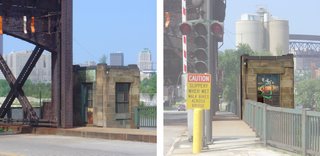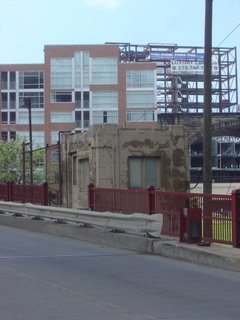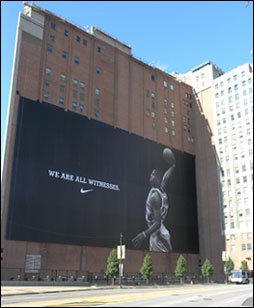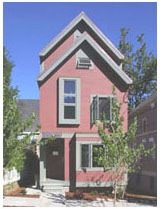[I apologize if this entry is a little off-topic… However, I think it is thought-provoking and relevant to designers]
What will future architecture be like? What new technologies will change the way we see and experience space? I believe that Radio Frequency Identification (RFID) may create major changes in architectural design. Whether we should openly accept them is another question.
Simply stated, RFID tracks and identifies materials using radio waves. Scanning devices broadcast electromagnetic energy through radio waves. When a tag enters this field, it responds by broadcasting its information. Tags need to be within a few inches of the scanner to be read. There are several types of tags, with some more secure than others. RFID has several applications. RFID security badges are replacing many magnetic swipe badges. “Smart” credit cards use RFID to increase consumer security. Wal-Mart requires pallets and shipping containers to incorporate RFID for easy inventory. Some libraries use it for quick circulation of materials. Farmers track livestock using RFID. Pets often have implanted RFID tags in case they get lost. A veterinarian simply scans the pet’s tag which broadcasts a number that corresponds to a record containing the pet’s information.
This entry was inspired my recent research into RFID and the Thursday August 3, 2006
WCPN program of “90.3 at 9.” You can listen to it or download it here:
http://www.wcpn.org/podcast/nine.xml. The radio program featured two guests: John Procter of the
Verichip Corporation and Chris Ling of
ACLU of Ohio. They discussed Cincinnati-based CityWatchers’ decision to offer VOLUNTARY RFID implants to employees for security purposes. The tags, implanted in employees’ arms, allow for quick secure access to certain areas. It is said to eliminate the problem of employees borrowing others’ security passes. Googling Citywatchers will give you some articles about the decision.
As the program mentioned, human-implanted RFID has useful, although controversial, medical applications. An implanted tag can instantly notify paramedics of important patient conditions, such as diabetes, hemophilia, etc. Even still, I believe many people will (and should) be wary of implanted RFID.
Overall, the radio program’s discussion was basic and introductory. However, I feel Ms. Ling of the ACLU did not have a full grasp of the technology. She relied primarily on scare tactics and poor terminology. This is not saying that I support implanted RFID, rather I think her presentation did not address some major issues. For example, she missed a great opportunity when the RFID hacking was introduced. A caller mentioned the interesting
Wired article entitled
“The RFID Hacking Underground”. Mr. Procter of Verichip dismissed the prospects as negligible, however I think the topic required additional discussion.
As mentioned, privacy concerns require careful attention. While tags broadcast a number that has no meaning without a corresponding database, it coulf be easy to determine the proper database by following an individual into a building or hacking into various systems. Therefore, implanted RFID requires careful evaluation by the public and lawmakers. In addition, individuals must make their own decisions about implantation. However, as the program mentioned, people can be pressured into ‘volunteering.’ While I do not believe that this is a corporate (or government) conspiracy to control our lives, I believe that are major, legitimate concerns that must be addressed.
However, let’s put aside the controversy for a while. What can RFID change in architecture? Image a tag (whether worn or implanted) that only contains personal preferences (i.e. how much light, sound levels, etc.), and not security purposes. Architecture can take on an Active, rather than Passive role. The architecture responds to its occupants. While RFID cannot “track” individuals, placing multiple scanners in carefully positioned locations, such as chairs, doorways, and desks, can determine which people occupy a room and their average lighting or temperature preferences. Computer systems can automatically shut off lights in empty rooms. Energy can possibly be saved with these systems. Smart refrigerators can read tagged products and determine its contents and expiration date. While these are practical solutions, the physical space / experience may also change as people move through it. People interested in responsive architecture (not necessarily RFID implementations) should check out
Interactive Architecture Dot Org .
Obviously, RFID has implications beyond creating responsive homes and workplaces. Its impact on architecture is (probably) very small compared to other sectors.
Our world has become more interactive and intrusive through measures beyond RFID. We often give up privacy for better (?) service. Every time I visit Amazon.com, it provides me with pretty good book recommendations that are based on my past purchases. At the grocery store, printed coupons on receipts are based on Advantage card records. Frequent credit card users can easily have their daily lives indirectly tracked by credit card companies. I have to say I like coupons and book recommendations. I think others do too. However, at what point will people prefer privacy over its potential benefits? Should we stop before implanting chips in our bodies? Should architects and designers specify / incorporate these systems into their designs? Do they have a choice?
In 50 years our implanted RFID tag may be keeping us physically comfortable and saving us money while we wonder what all this fuss was about. Are opponents standing in the way of progress? On the flip side, I see corporations (or governments) with access to every detail of our existence. Are opponents trying to save us all? Without a doubt, RFID will continue to make its way into our culture through commercial usage (inventory, etc.). How far will it permeate our lives? Where the line is drawn is (hopefully) up to us.
 Rock'n RNC? If Cleveland is the Rock'n Roll capital of the world, whoever chose this slogan should know that Rock'n Roll and Republicans do NOT go together. War, corporate greed and advancing the police state are all values of rock'n roll? The irony sickens me, and I am a glutton for irony. But really the issue isn't about the Republicans and their policies, its about those who chose this slogan. Cleveland has milked this Rock'n Roll legacy enough. Rock'n Roll is dead. It died decades ago. Its time to be serious and endeavor to find something else of value to rest our laurels rather than an expensive and ill-conceived museum.
Rock'n RNC? If Cleveland is the Rock'n Roll capital of the world, whoever chose this slogan should know that Rock'n Roll and Republicans do NOT go together. War, corporate greed and advancing the police state are all values of rock'n roll? The irony sickens me, and I am a glutton for irony. But really the issue isn't about the Republicans and their policies, its about those who chose this slogan. Cleveland has milked this Rock'n Roll legacy enough. Rock'n Roll is dead. It died decades ago. Its time to be serious and endeavor to find something else of value to rest our laurels rather than an expensive and ill-conceived museum. Rock'n RNC? If Cleveland is the Rock'n Roll capital of the world, whoever chose this slogan should know that Rock'n Roll and Republicans do NOT go together. War, corporate greed and advancing the police state are all values of rock'n roll? The irony sickens me, and I am a glutton for irony. But really the issue isn't about the Republicans and their policies, its about those who chose this slogan. Cleveland has milked this Rock'n Roll legacy enough. Rock'n Roll is dead. It died decades ago. Its time to be serious and endeavor to find something else of value to rest our laurels rather than an expensive and ill-conceived museum.
Rock'n RNC? If Cleveland is the Rock'n Roll capital of the world, whoever chose this slogan should know that Rock'n Roll and Republicans do NOT go together. War, corporate greed and advancing the police state are all values of rock'n roll? The irony sickens me, and I am a glutton for irony. But really the issue isn't about the Republicans and their policies, its about those who chose this slogan. Cleveland has milked this Rock'n Roll legacy enough. Rock'n Roll is dead. It died decades ago. Its time to be serious and endeavor to find something else of value to rest our laurels rather than an expensive and ill-conceived museum.




